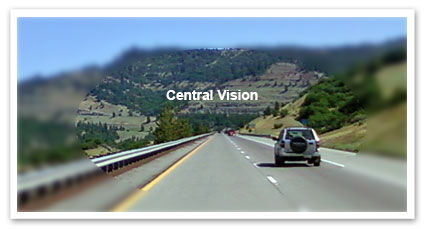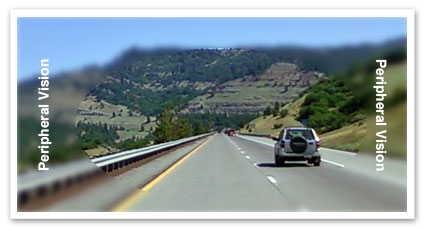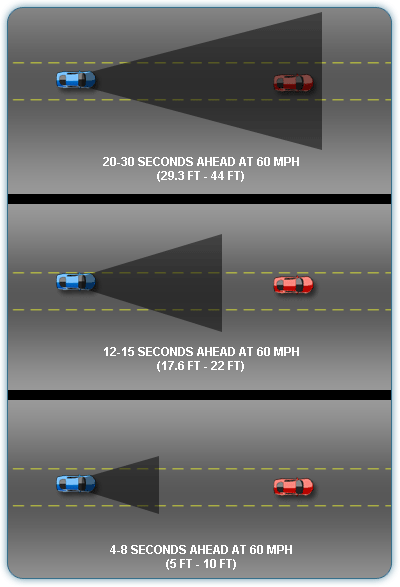Line of Sight
Line of sight refers to the path you can see without an object (e.g., a hill, curve, or other vehicle) obstructing your vision. Let's say you're driving on a flat road and there's a stop sign ahead. Imagine a straight line starting with your eyes and ending with the stop sign. There is nothing blocking this imaginary "line," so you're able to clearly see the path ahead of you.
Now imagine you're driving on the same road, but there is a large truck driving directly ahead of you. Now when you look at the imaginary line, it is interrupted by the truck—your line of sight to the stop sign has been obstructed.
 Stop Sign
Stop Sign
Field of Vision
In order to better understand line of sight, it's important to familiarize yourself with your field of vision. Field of vision is the area a driver can see while looking straight ahead. This includes central vision and peripheral vision.
Central Vision is your clear, direct sight, and it corresponds closely with your line of sight. It extends from the center of your vision out in a 10-degree cone and sends sharply focused pictures to the mind.
 Central Vision
Central Vision
Peripheral vision allows you to see out of the corner of your eyes. You do not see objects in your periphery as clearly as objects in your direct line of sight, but peripheral vision does pick up movement and light. Peripheral vision is used for scanning your environment and alerts you to objects and hazards that you can turn and see with your sharper, central vision.
 Peripheral Vision
Peripheral Vision
Drivers rely on peripheral vision to support a number of tasks while driving, such as maintaining speed and lane position and detecting potential hazards.
In your visual field, your peripheral vision could extend to about 180 degrees. However, as speed increases, your peripheral vision range narrows rapidly. This means that the faster you drive, the less you are able to distinguish objects to either side.
Targeting
So, what can we do when our line of sight and field of vision is obstructed on the road?
One way is to use visual targeting, which means setting up good sightlines for referencing and good peripheral fields for seeing changes.
The first step in visual targeting is to look far down your line of sight, or look as far ahead as you can see. Usually, this area is about 20 to 30 seconds ahead of you, which gives you plenty of time to identify any potential hazards and prepare for them. Look for objects in your path of travel or the space your vehicle will occupy as you travel on the roadway. Is traffic slowing down ahead? Do you notice a car weaving recklessly in and out of traffic? Do you see a pedestrian crossing the road? Are there any potholes or debris in your lane? You may need to adjust your lane position (where you’re at in the lane) to maximize your line of sight. However, for the most part, you should remain in the center of your lane.
Next, look at the area halfway between your vehicle and the end of your line of sight. This area should be about 12 to 15 seconds ahead of you. Again, evaluate your path of travel. If you noticed a potential hazard up ahead, now’s the time to start reacting to it. Activate your brakes if you notice traffic slowing down. Switch into another lane to put some space between you and the reckless driver that you spotted.
 Search Area
Search Area
Finally, look at the area 4 to 8 seconds ahead of you, or your immediate path of travel. The key thing to evaluate in this zone is your following interval, or how much space you have between your car and the car in front of you. You must make sure there's always enough room between you and the vehicle in front of you so you can come to a quick stop if needed.
To figure out your following interval, choose a fixed object in the distance, such as tree or post. After the car in front of you has passed that object, start counting (i.e. “one one thousand, two one thousand, three one thousand, four one thousand”). When you reach the object, stop counting. Experienced drivers should keep a following distance of about 2-3 seconds in good conditions, and novice drivers should double that.
Another thing to pay attention to in the 4 to 8 second zone is the space to the sides and rear of your vehicle (i.e., your space cushions). If you can move freely into these spaces without colliding with another vehicle or object, or causing another driver to react quickly in response to you, then this cushion is open. If a vehicle or object is already occupying this space or if it is dangerous for you to move into this space, then this cushion is closed. You should always leave at least two spaces open in case of an emergency. It is dangerous to be blocked in on all sides.